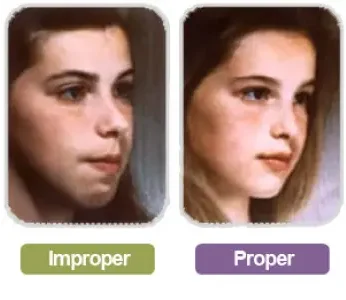
Why do these identical twins look so different?
SIGNS OF IMPROPER REST ORAL POSTURE
- Lips apart at rest
- Lip strain with flattening or wrinkling of chin when lips are closed
- Flaccid, rolled-out upper lip
- Crusty lips
- Accentuated “cupid’s bow” appearance of upper lip
- Flattened cheeks
- One or both jaws recessed from ideal position
- Nose-lip angle greater than 110 degrees
To ignore poor oral posture and simply straighten the teeth treats a symptom and ignores a cause…
Proper oral posture means that at rest the tongue is to the roof of the mouth, the teeth are touching or slightly apart, and the lips are together without strain. When a child grows up with proper oral posture the face develops in appropriate balance according to its genetic plan. Also, there is proper balance between the forces of the tongue and the cheeks, and the teeth tend to come in to relatively good positions. Proper oral posture also contributes to a more stable orthodontic result. (The twin on the right is an example of this.) When a child grows with poor oral posture the teeth are usually affected in a number of ways, and facial balance always suffers. Often, both jaws fall back from their proper intended positions in the face. When the tongue is low and the teeth and lips are apart at rest, crowded teeth, gummy smiles, recessive chins, and long faces result. (The twin on the left is an example of this.)
